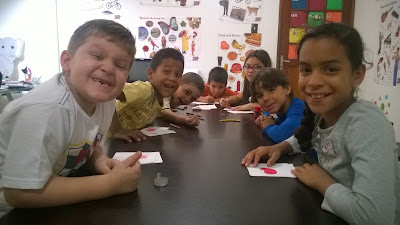Hi
everyone! For this second record of work, I want to begin describing a teaching
strategy I have applied so far with my children, here in my English Academy
called “Little Big Students”. My little group is formed by kids from 5 to 11
years old. The strategy is called “apples and bananas”. This strategy is about
singing a song that says “I like to eat, eat, eat apples and bananas” and then,
singing again the same sentence but with the different sounds of each vowel. So
the song, with letter A sound, goes like this: “I like to eit, eit, eit, eipples
and beineineis” then with E sound, I, O and U. It is a very easy song for them
but powerful at the same time, because it helps them to establish a
relationship between each vowel with their sounds, which is very important for
me as a teacher. I say it is important for me because, one of the things that
didn’t go so well is when my kids confuse the vowel sound in English with their
sounds in Spanish, for example: sometimes I asked “which is this letter?” pointing
at letter E, and they say “ei” instead of “i”. This is absolutely frustrating
for me so that’s why I took a decision of applying that “apples and bananas
song” to make them practice all the vowel sounds. From now on, I will keep
applying this strategy into my daily teaching practice. For me, it’s perfect
and I won’t change anything from it.
Here you
have the video of the “apples and bananas” song. Enjoy!
https://www.youtube.com/watch?v=WQqtlgIh5cY&feature=youtu.be
https://www.youtube.com/watch?v=WQqtlgIh5cY&feature=youtu.be
As you
know, pronunciation is essential in English, and teach it should be a little
challenging for us as teachers, but not impossible. A good strategy that I
would apply with my bigger students will be “questions using minimal pairs”. I consider
that minimal pair’s activities will have a good reception from my bigger
students because it can be funny for them to know that one word can be very
similar to another word. Another complement for this activity can be the exaggerated
articulation of the words in order to make students comprehend the word
carefully.
Another important
thing that I have learnt here in this course is to give instructions to the
students. I mean, I used to say to them what they were supposed to do and that’s
it. But now, that changed. Now, I give them instructions and then make my
students repeat what I said to make sure they got the information or the steps
to complete the task correctly. First, it was a little bit disappointing because
the first time I asked “what did I say?” none of my kids answered, but they
learnt fast and now, they follow my instructions on the rest of the activities.
What a good feeling!
By the way,
there is something I would like to try. I was thinking on combine the
identification of errors and mistakes with a ball throwing game. I would like
to ask my students to make a circle, then write a correct or incorrect sentence
(or word, if they are too young) on the blackboard and throw a ball. The student,
who receives the ball, should explain to the rest of the class why the sentence
(or word) is incorrect or correct. That can be an excellent idea!
